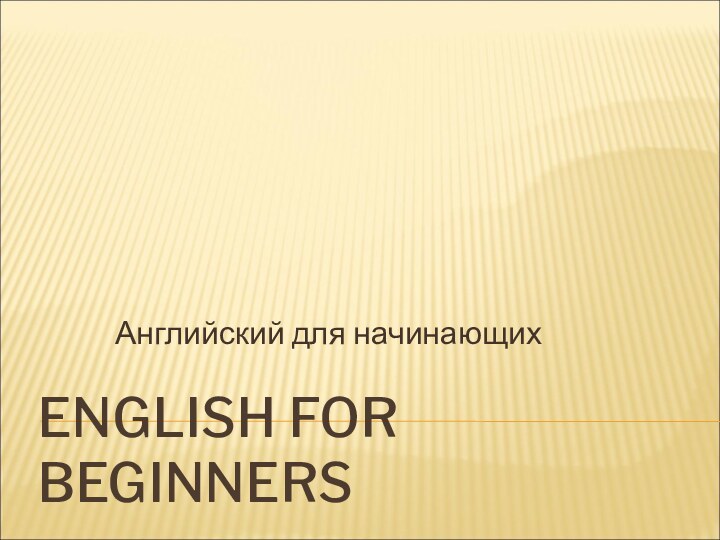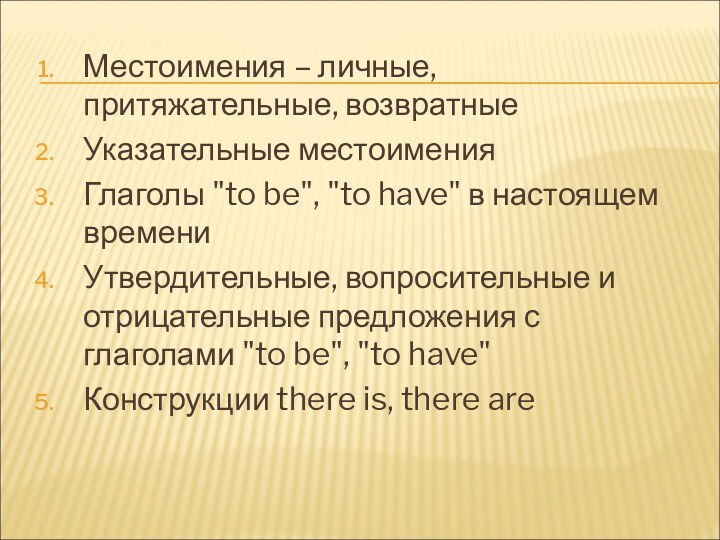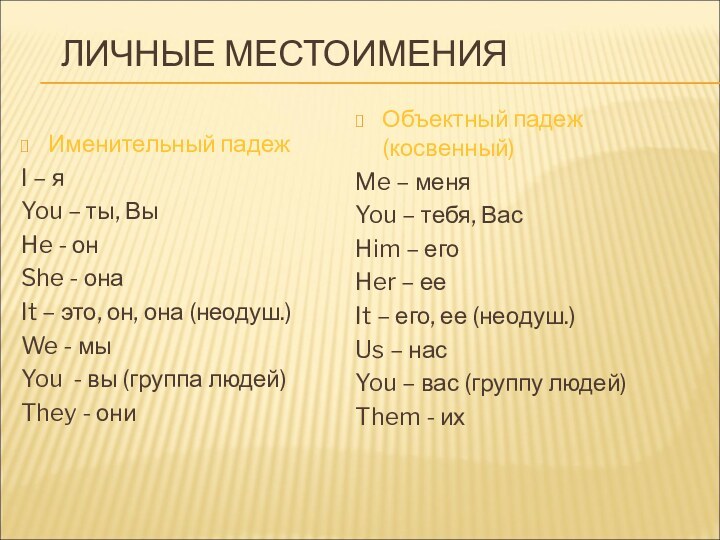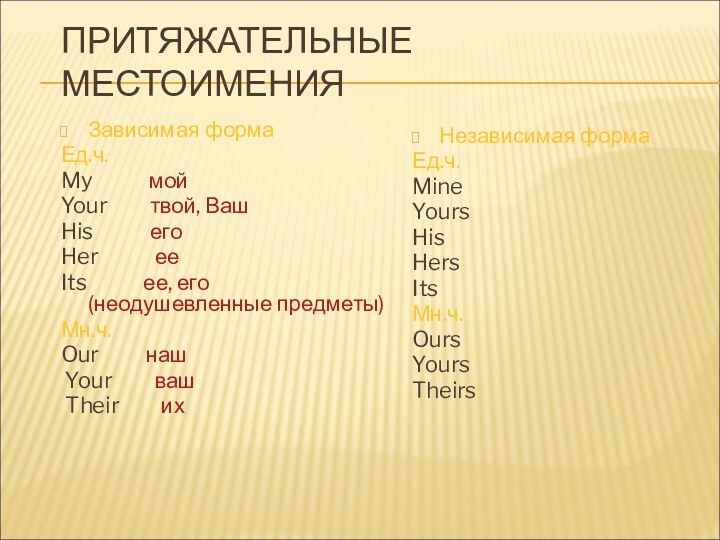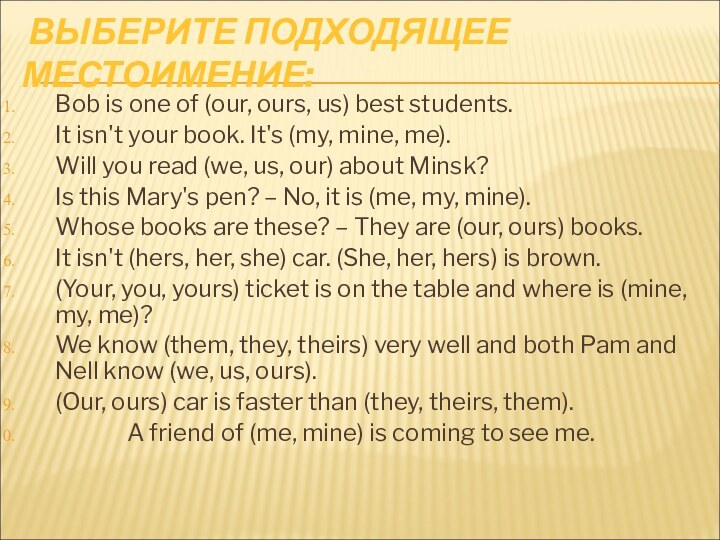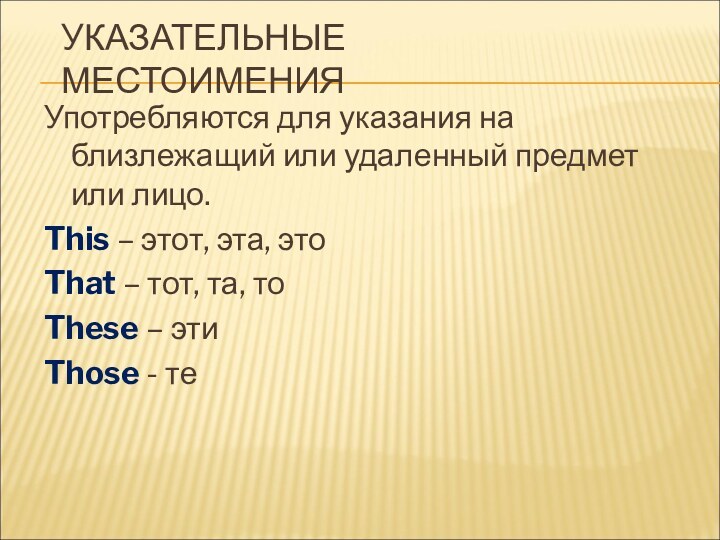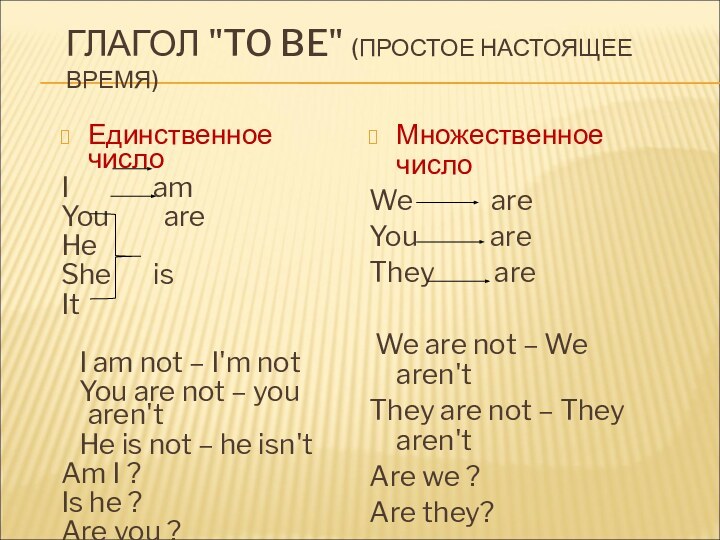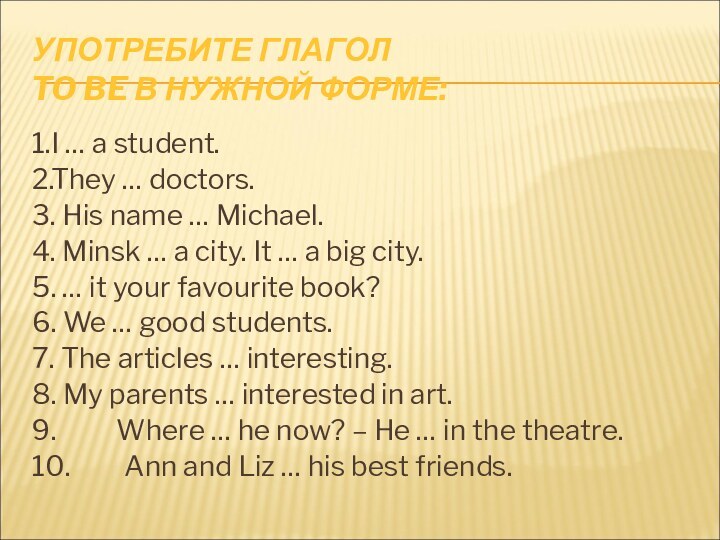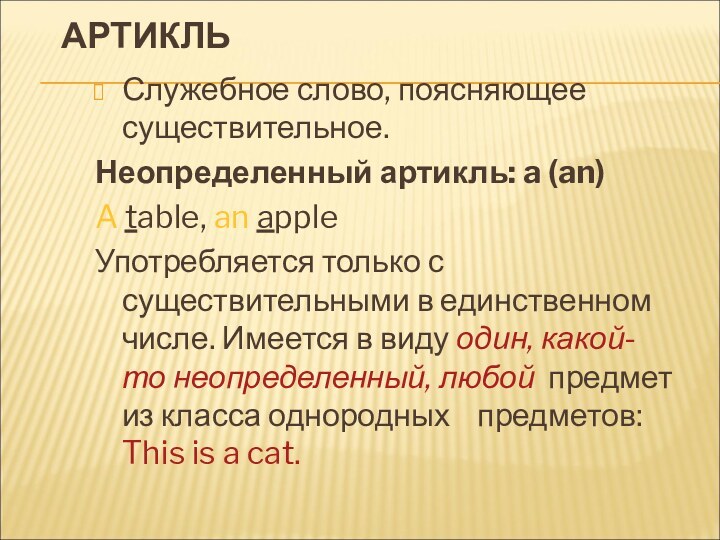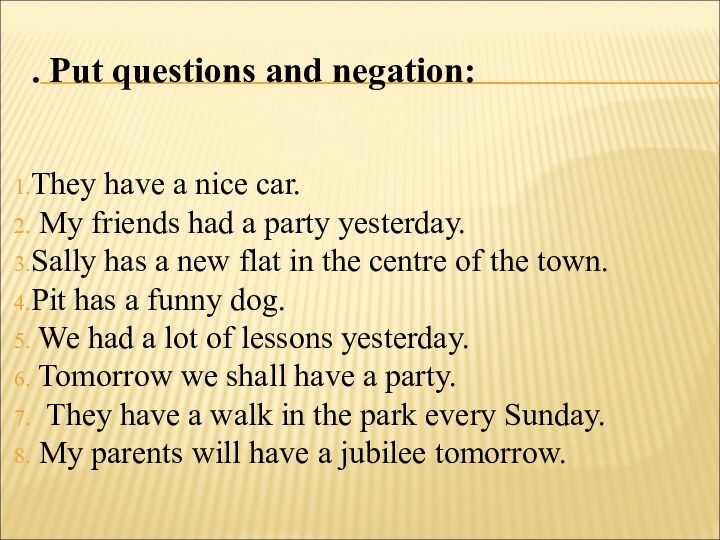Слайд 2
Местоимения – личные, притяжательные, возвратные
Указательные местоимения
Глаголы "to be",
"to have" в настоящем времени
Утвердительные, вопросительные и отрицательные предложения
с глаголами "to be", "to have"
Конструкции there is, there are
Слайд 3
ЛИЧНЫЕ МЕСТОИМЕНИЯ
Именительный падеж
I – я
You – ты, Вы
He
- он
She - она
It – это, он, она (неодуш.)
We
- мы
You - вы (группа людей)
They - они
Объектный падеж (косвенный)
Me – меня
You – тебя, Вас
Him – его
Her – ее
It – его, ее (неодуш.)
Us – нас
You – вас (группу людей)
Them - их
Слайд 4
ПРИТЯЖАТЕЛЬНЫЕ МЕСТОИМЕНИЯ
Зависимая форма
Ед.ч.
My
мой
Your твой, Ваш
His
его
Her ее
Its ее, его (неодушевленные предметы)
Мн.ч.
Our наш
Your ваш
Their их
Независимая форма
Ед.ч.
Mine
Yours
His
Hers
Its
Мн.ч.
Ours
Yours
Theirs
Слайд 5
ВЫБЕРИТЕ ПОДХОДЯЩИЕ ПО СМЫСЛУ МЕСТОИМЕНИЯ:
(I, my, me)
parents are old people.
(They, them, their) are pensioners.
(They, them, their) have a house in the country.
(They, them, their) house is small.
(I, me, my) usually go to see (they, them ,their) on Sunday.
Слайд 6
(I, me, my) brother and (he, him,
his) family live in Moscow.
Sometimes (I, me, my)
go to Moscow to see (they, them, their).
Слайд 7
(We, us, our) students study a lot.
(They,
them, their) have four lessons every day.
(They, them,
their) lessons begin at 8 a.m.
(They, them, their) teacher asks (they, them, their) a lot of questions and the students answer (they, them, their).
Слайд 8
(I, me, my) elder sister has a new
flat.
(She, her) flat is very good.
(She, her)
likes (it, its) very much
Слайд 9
УПОТРЕБИТЕ ПРИТЯЖАТЕЛЬНЫЕ МЕСТОИМЕНИЯ ВМЕСТО СУЩЕСТВИТЕЛЬНЫХ В ПРИТЯЖАТЕЛЬНОМ ПАДЕЖЕ:
1.Take Mike’s book off the table!
2.Give me Kate’s
pen.
3.What’s the girl’s name?
4.How old is Mr. Black’s son?
5.Where are your friends’ children now?
6.This is my friend’s daughter.
7.These are Mr. Loveson’s telexes.
8.Take Kate’s book from Peter’s sister.
9.The engineers’ desks are in that room.
10.Come up to the engineer’s desk.
Слайд 10
ВЫБЕРИТЕ ПОДХОДЯЩЕЕ МЕСТОИМЕНИЕ:
Bob is one of
(our, ours, us) best students.
It isn't your book. It's
(my, mine, me).
Will you read (we, us, our) about Minsk?
Is this Mary's pen? – No, it is (me, my, mine).
Whose books are these? – They are (our, ours) books.
It isn't (hers, her, she) car. (She, her, hers) is brown.
(Your, you, yours) ticket is on the table and where is (mine, my, me)?
We know (them, they, theirs) very well and both Pam and Nell know (we, us, ours).
(Our, ours) car is faster than (they, theirs, them).
A friend of (me, mine) is coming to see me.
Слайд 11
ВОЗВРАТНЫЕ МЕСТОИМЕНИЯ
I – myself
You – yourself
He – himself
She
– herself
It – itself
We – ourselves
You – yourselves
They -
themselves
I shall read it myself.
Do it yourself!
He washed himself.
She speaks only about herself.
The dog was washing itself.
We enjoyed ourselves.
You did the test yourselves.
They can do it themselves.
Перевод : себя, собой, себе, сам, сама, сами
Слайд 12
УКАЗАТЕЛЬНЫЕ МЕСТОИМЕНИЯ
Употребляются для указания на близлежащий или удаленный
предмет или лицо.
This – этот, эта, это
That – тот,
та, то
These – эти
Those - те
Слайд 13
ПРЕОБРАЗУЙТЕ ПРЕДЛОЖЕНИЯ ПО ОБРАЗЦУ:
ЕД.Ч. THIS IS A TABLE.
МН.Ч.THESE
ARE TABLES.
This is a nice city.
Is that bag new?
This
letter is mine. Don't read it.
That pen is not mine.
This is not a tasty apple.
Is that cinema big?
This is a new modern house.
Слайд 14
ГЛАГОЛ "TO BE" (ПРОСТОЕ НАСТОЯЩЕЕ ВРЕМЯ)
Единственное число
I
am
You
are
He
She is
It
I am not – I'm not
You are not – you aren't
He is not – he isn't
Am I ?
Is he ?
Are you ?
Множественное число
We are
You are
They are
We are not – We aren't
They are not – They aren't
Are we ?
Are they?
Слайд 15
УПОТРЕБИТЕ ГЛАГОЛ
TO BE В НУЖНОЙ ФОРМЕ:
1.I …
a student.
2.They … doctors.
3. His name … Michael.
4.
Minsk … a city. It … a big city.
5. … it your favourite book?
6. We … good students.
7. The articles … interesting.
8. My parents … interested in art.
9. Where … he now? – He … in the theatre.
10. Ann and Liz … his best friends.
Слайд 16
ГЛАГОЛ "TO BE" (ПРОСТОЕ ПРОШЕДШЕЕ ВРЕМЯ)
Единственное число
I
He
She was
It
I was not – I wasn’t
Was I ?
Was she ?
Множественное число
We were
You were
They were
We were not
They were not
Were we ?
Were they?
Слайд 17
ГЛАГОЛ "TO BE" (ПРОСТОЕ БУДУЩЕЕ ВРЕМЯ)
Единственное число
I
- shall be
You
He will be
She
It
I shall not be– I shan’t be
You will not be– You won’t be
Shall I be ?
Will You be ?
Множественное число
We shall be
You will be
They
Слайд 18
TO BE (AM, IS, ARE, WAS, WERE, WILL
BE):
Lora _____ a nice girl. She _____ an economist.
Last year she ____ in London on business.
Pit and Doris ____ my friends. They _______ students. Yesterday they ______ in the theatre.
This ____ a cat. It ____ a nice cat. Now it ___ very big. The cat ____ very small last year.
This ___ my son. He ___ a pupil. Next year he ______ a student.
Hi! We ____ very glad to see you! Where _____ you yesterday? We phoned you.
This ____ Lora and this ___ Sally. They ____ my best friends. They ______ students.
Last year he ___ twenty-four. Now he ____ twenty-five. Next year he _______ twenty-six.
Слайд 19
ПРЕОБРАЗУЙТЕ ПРЕДЛОЖЕНИЯ В ОБЩИЕ ВОПРОСЫ.
It's a theatre. It's
big and nice.
He is a scientist. His name is
Tim Gibson. He is talented. He is Jim's teacher.
This is Mr Finn's sister. She is an economist.
That is Mr Hint's picture there. The picture is nice.
This is Mr Hale's plan. It's a clever plan.
Mr Hale is an engineer. He is here.
Слайд 20
ГЛАГОЛ "TO HAVE" (ИМЕТЬ) SIMPLE PRESENT
Ед.число
I
have (I've)
You have
He
She has (he's)
It
Мн.число
We
have
You have
They have
We've, they've
Have not – haven't
Has not – hasn't
Слайд 21
ГЛАГОЛ "TO HAVE" (ИМЕТЬ) SIMPLE PAST
Ед.число
I
You
He
had
She
It
Мн.число
We
You had
They
Had not – hadn't
Had we?
Слайд 22
ГЛАГОЛ "TO HAVE" (ИМЕТЬ) SIMPLE FUTURE
Ед.число
I
You
He
will have
She
It
Мн.число
We
You will have
They
will not have – won’t have
Will he have?
Слайд 23
To have (has, have, had, will have):
Lora ____
three children. She is pregnant. In a month she
_______ a baby.
Yesterday I ___ an English lesson
We ____ a very nice house in the country.
Last year we _______ four computers in our office.
Tomorrow they __________ a party. They ________ a good time.
Слайд 24
АРТИКЛЬ
Служебное слово, поясняющее существительное.
Неопределенный артикль: a (an)
A table,
an apple
Употребляется только с существительными в единственном числе. Имеется
в виду один, какой-то неопределенный, любой предмет из класса однородных предметов: This is a cat.
Слайд 25
ОПРЕДЕЛЕННЫЙ АРТИКЛЬ
THE
The book, the dog
Имеется в виду
определенный конкретный предмет или явление. Употребляется с существительными в
ед. и мн. числе.
Who can answer the question?
Кто может ответить на (этот) вопрос?
Слайд 26
ЗАПОЛНИТЕ ПРОПУСКИ АРТИКЛЯМИ, ГДЕ НЕОБХОДИМО:
He is … teacher.
… teacher is clever.
This is … dog and that
is … cat. … dog never bites … cat.
They are … students. … students are at their … lessons.
This is … book. … book is on the desk. It is … interesting book.
Слайд 27
КОНСТРУКЦИИ С ВВОДЯЩИМ THERE (THERE IS, THERE ARE)
Указывают
на наличие или отсутствие какого либо лица или предметов.
There – формальное подлежащие.
Перевод – имеется, находится, лежит и т.д. или не переводится. Начинать перевод следует с обстоятельства места (слово отвечающее на вопрос где?):
There is a big desk in the room.
В комнате находится (стоит) большой письменный стол.
Слайд 28
There are some children in the street.
На улице
дети.
There is a pen on the desk.
На столе лежит
ручка.
There aren't any mistakes in your test.
В вашей контрольной работе нет ошибок.
There is a table and two chairs in the kitchen.
В кухне находится стол и 2 стула.
Слайд 29
ВОПРОСИТЕЛЬНЫЕ ПРЕДЛОЖЕНИЯ:
Для построения вопроса глагол to be выносится
вперед.
Are there any children in the street?
На улице есть
дети?
Yes, there are. No, there aren't.
Is there a pen on the desk?
На столе лежит ручка?
Yes, there is. No, there isn't.
